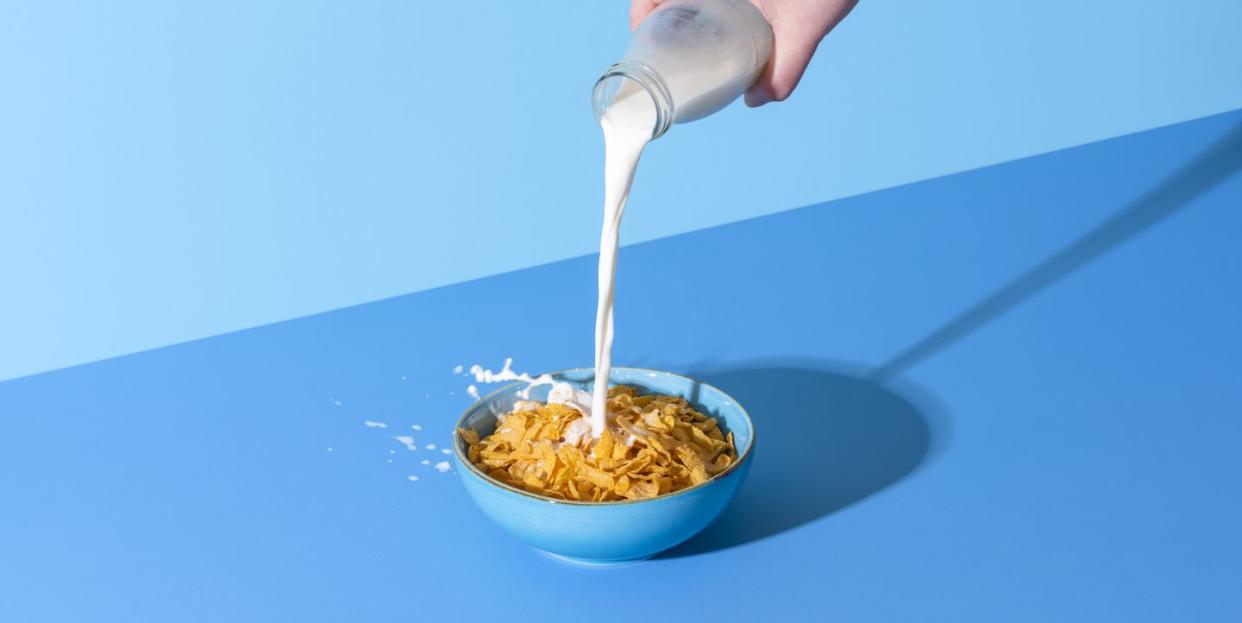An Expert Just Shared a Genius Hack to Check If Your Almond Milk Has Gone Bad

Everyone knows that best-by dates are often a suggestion rather than a hard-and-fast rule, but detecting when almond milk has really gone foul is harder than detecting regular spoiled milk. This is especially true for those who may be new to drinking and cooking with alt milk in their home; almond milk flavors can differ subtly between brands, and if you're not an alt-milk pro, it's hard to pinpoint when something is just a little too off for your liking.
New almond milk shoppers will also quickly realize that there is more than one kind of alt milk available to them (hello oat milk!) in their supermarket. You may be skewed to one particular product over another — i.e. shelf-stable milk versus chilled — depending on how long you'd like to keep milk fresh at home.
Like other shelf-stable dairy milk, this kind of almond milk is usually ultra-high-temperature pasteurized, as marked by a "UHT" symbol on its packaging. "This pasteurization treats the milk in a way that low heat can't, and while it tastes slightly different than other almond milk, it's more hygienic and less likely to harbor pathogens, meaning it can stay [unopened] on the shelf for years," explains Celine Beitchman, the director of nutrition at the Institute of Culinary Education in New York.
In any case, both shelf-stable and chilled almond milk begin to degrade in quality whenever you open the box or bottle. Most any variety should be stored in the back of your fridge, where the temperature is evenly cold, and if you're wondering where to store boxed varieties, place it in a cool, dark spot.
For chilled, refrigerated bottles or cartons, almond milk should be consumed within a week and a half to ensure optimal freshness, Beitchman says. Shelf-stable almond milk will need to be moved into a fridge once it's been opened, and should remain fresh for up to two weeks tops after being opened, she adds. Those who like to create DIY almond milk, or purchase artisanally made almond milk from a purveyor at a farmer's market, won't enjoy pasteurized milk in the same way that commercially made almond milk is. You may notice odors or clumps within 7 days, which is usually a good sign that the milk is past its prime.
Of course, Beitchman explains that best-by dates and expiration dates vary wildly and that you could enjoy almond milk even after the first 10 days have passed. If you're wondering if your almond milk is still fresh, Beitchman shares a quick test below that you can use to see whether or not you should toss it for good.
How to tell if almond milk is spoiled:
There are a few ways to tell if your almond has separated without having to sip or sniff it blindly. The easiest way, according to Beitchman, is to use a cup of hot coffee to your advantage.
Adding a bit of your almond milk into a cup of hot coffee is a simple freshness test, as almond milk often separates on its own — not a sign that it's spoiled necessarily, since you can shake it up and enjoy it once more — and sour flavor notes can usually slide past a sip or two. Once in hot coffee, however, Beitchman says that spoiled milk will curdle on its own: "You'll see it spill off into tiny little kernel particles."
You can also tell if your almond milk is spoiled if:
It's curdled in the carton or fully separated even if you've recently taken it out of the fridge.
It's overly bitter or acrid in taste, especially if there is an added sweetener in the variety you're buying.
The best way to prevent your almond milk from going bad, Beitchman adds, is to portion out enough that you'll consume it in two to three days.
If you're making almond milk by hand, or if you have a glut of almond milk available in your pantry, you can save extra almond milk from going bad by storing excess in an ice cube tray in the freezer. "You should use that extra milk in things that don't require defrosting, like smoothies or recipes where it's hidden in the background because the frozen version will always separate or curdle when defrosted," she says.
You Might Also Like

